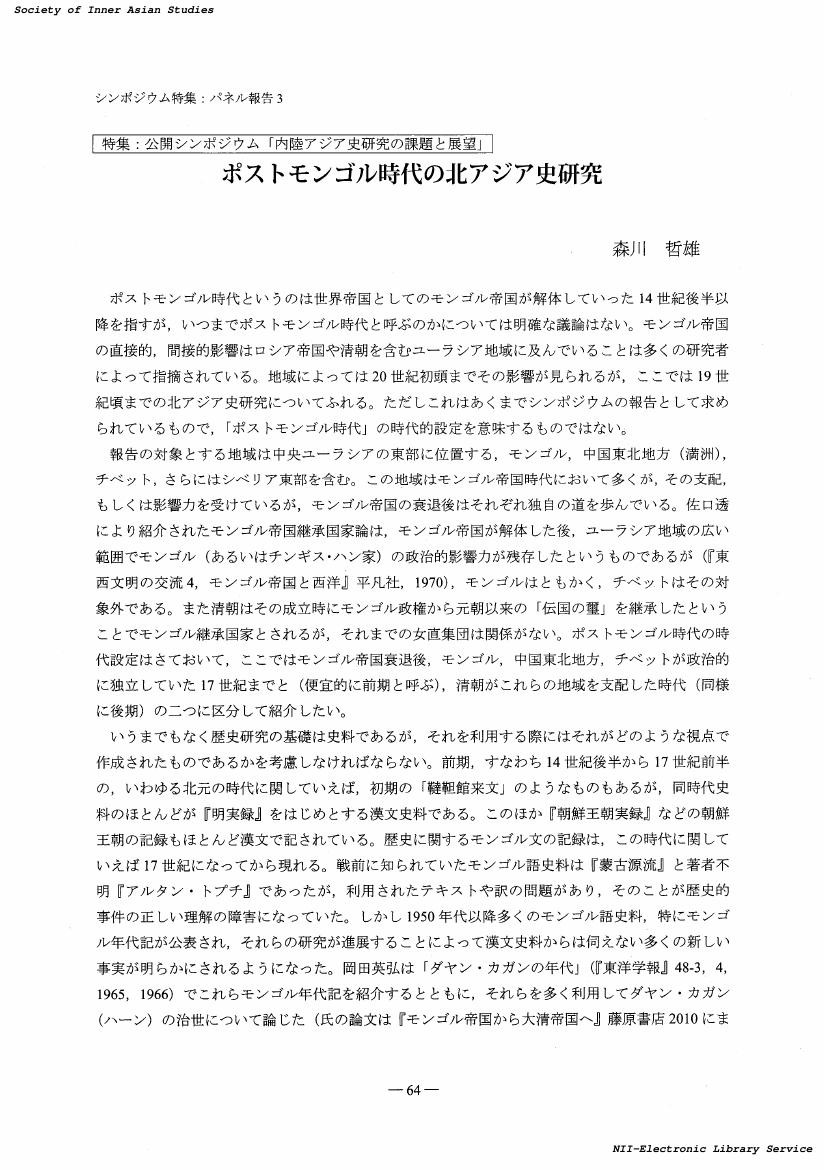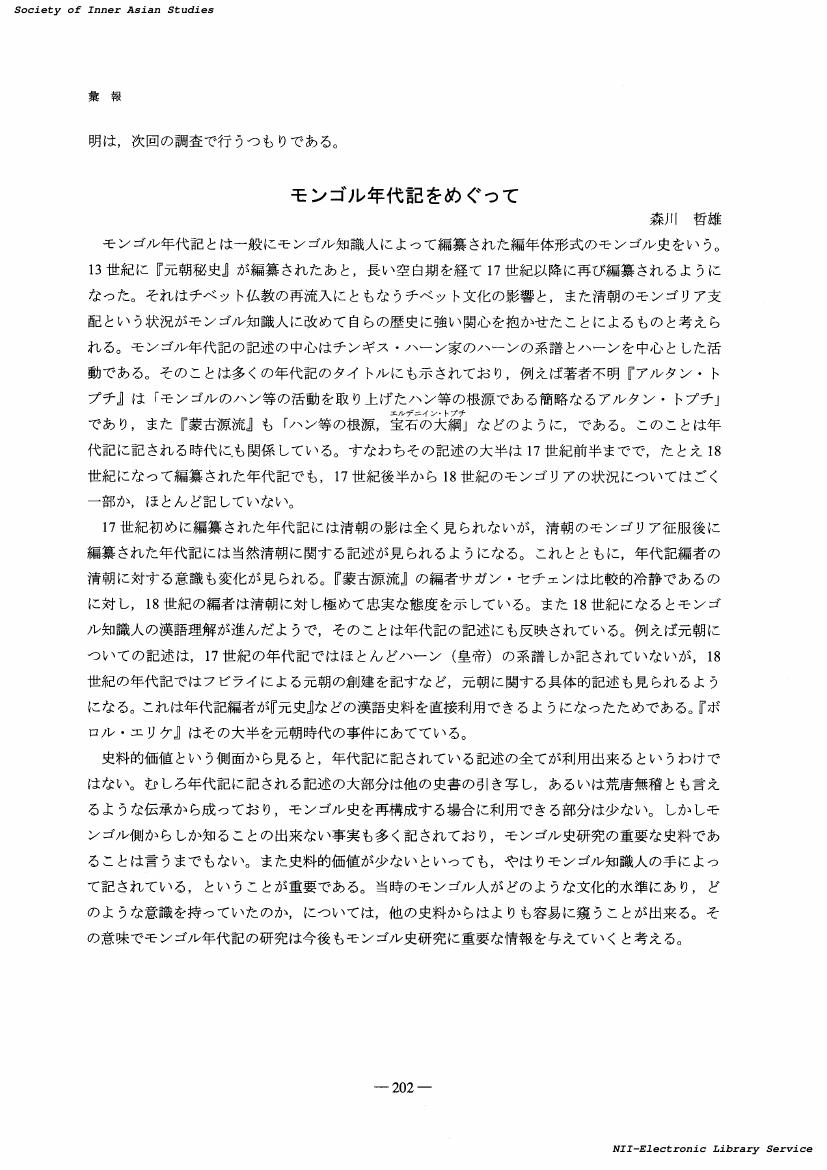- 著者
- 森川 哲雄
- 出版者
- 内陸アジア史学会
- 雑誌
- 内陸アジア史研究 (ISSN:09118993)
- 巻号頁・発行日
- vol.26, pp.64-68, 2011-03-31 (Released:2017-10-10)
2 0 0 0 IR 大元の記憶
- 著者
- 森川 哲雄
- 出版者
- 九州大学大学院比較社会文化学府
- 雑誌
- 比較社会文化 (ISSN:13411659)
- 巻号頁・発行日
- vol.14, pp.65-81, 2008
In this paper, it is argued a problem how was memorized the name of the Dai Yuan ulus(The Great Yuan dynasty)and its activity by Mongolians of later ages. The Yuan dynasty was founded by Khubilai khan and so it was also called the Khubilai dynasty. However rule of Mongolia by descendants of Khubilai stopped once in the end of the 14th century. It is known that descendants of Arigbukha and Ogedei ruled over Mongolia for a while afterwards. Nevertheless the Mongolians of those days had the recognition that the Yuan dynasty still continued. Dayan khan who succeeded the khan throne at the end of the 15th century called himself the Great khah of the Ta Yuan(the Great Yuan)for the Ming government. But there is no description on the foundation of the Yuan dynasty by Khubilai in the Mongol chronicles edited in the 17th century.One of the editors of chronicle interprets a meaning of Dayan of Dayan khan as "whole" not "the Great Yuan". This means that memory of the Yuan dynasty faded among the Mongolian intellectuals of the 17th century. However editors of chronicle described in the 18th century write down clearly that the founder of the Yuan dynasty is Khubilai and Dayan means the Great Yuan dynasty. The reason of why they became to understand Chinese and edited chronicles using Chinese materials, especially the Histoly of the Yuan dynasty.
- 著者
- 森川 哲雄
- 出版者
- 東洋史研究會
- 雑誌
- 東洋史研究 (ISSN:03869059)
- 巻号頁・発行日
- vol.61, no.1, pp.138-170, 2002-06-30
This article re-examines previous theories concerning the problems regarding the Mongol chronicles compiled in the seventeenth and eighteenth centuries, and then suggests how they should be employed in the study of Mongol history from the Ming to early Qing dynasties. The authors and dates of compilation of many of the chronicles from this period have not been recorded, and although bibliographic studies of the works have continued, many problems remain unanswered. One of these problems concerns the chronicle Sira tuɣuji and its relation to the Erdeni-yin tobci. It has been known that the title Erten-u mongɣol-un qad-un undusun-u yeke sira tuɣuji has been affixed to one manuscript of the Sira tuɣuji, and that this corresponds to one of the seven works employed in the compilation of the Erdeni-yin tobci. Given this fact, prevailing opinion has been that the Erdeni-yin tobci was compiled after the Sira tuɣuji, and is that the Sira tuɣuji was used in the compilation of the Erdeni-yin tobci, however, by comparing the contents of the Erdeni-yin tobci, and the Sira tuɣuji, l have confirmed that the two works share many passages, and although the Sira tuɣuji appears to abbreviate many portions of the Erdeni-yin tobci, the Erdeni-yin was compiled earlier and l have indicated in this article that the prevailing view is mistaken. l have also made clear the fact that the Sira tuɣuji employs the Asaraɣci neretu-yin teuke, which had been compiled in 1677. Additionally, given the fact that the lineage of princes recorded in the Sira tuɣuji records the names of those ennobled early in the eighteenth century, this also provides confirmation of the fact that the work was compiled in the early part of the eighteenth century. On the other hand, concerning the fact that one manuscnpt of the Sira tuɣuji has the same titleas one of the works consulted in the compilation of the Erdeni-yin tobci, it may be supposed that a later copyist familiar with the content of the Erdeni-yin tobci reused it. Additionally, although the chronicles compiled in Inner Mongolia in the seventeenth century influenced the chronicles produced later in Outer Mongolia, it is also clear that, in the eighteenth century, chronicles compiled in Outer Mongolia influenced those from Inner Mongolia.
1 0 0 0 OA チャハル・八オトクとその分封について
- 著者
- 森川 哲雄
- 出版者
- 東洋文庫
- 雑誌
- 東洋学報 = The Toyo Gakuho
- 巻号頁・発行日
- vol.58, no.1・2, pp.127-162, 1976-12
Čaqar Tümen, the most important myriarchy among mediaeval Mongolian tribal organizations, consisted of eight otoγ, Qaγučid, Kemǰigüd, Sönid and Üjümüçin of the Right Wing and Auqan, Naiman, Kesigten and Tatar of the Left Wing. The Left Wing otoγ first became private fiefs of Dayan Qaγan’s sons, and the Right Wing ones were later allocated by succeeding qaγans to their sons. The circumstances are referred to in Erdeni-yin Tobči with many errors, which should be corrected on the basis of other Mongolian chronicles The Čaqar otoγ were further subdivided as generations passed, as reported in such Mongolian sources as Gangga-yin Urusqal, Bolor Erike, Altan Kürdün Mingγan Kegesütü, etc.
- 著者
- 森川 哲雄
- 出版者
- 内陸アジア史学会
- 雑誌
- 内陸アジア史研究 (ISSN:09118993)
- 巻号頁・発行日
- vol.23, pp.202, 2008-03-31 (Released:2017-10-10)
1 0 0 0 OA チャハルのブルニ親王の乱をめぐって
- 著者
- 森川 哲雄
- 出版者
- 東洋文庫
- 雑誌
- 東洋学報 = The Toyo Gakuho (ISSN:03869067)
- 巻号頁・発行日
- vol.64, no.1・2, pp.99-129, 1983-01
In the spring of 1675, Prince Burni, head of the Inner Mongolian Chakhar tribe, rose in arms against the Manchu Ch’ing Dynasty of China, which was then afflicted by a large-scale rebellion in the south started by the so-called Three Feudatories. Taking advantage of this situation, the prince, along with some other Inner Mongolian chiefs who cooperated with him, aimed at liberating his people from the Manchu yoke and bringing back the old glory of the Chakhar Khanate. Not surprisingly, official Ch’ing sources supply only scant information as to what caused this rebellion and how it developed. At that time, the Koreans of the Yi Dynasty Joseon Kingdom, with their barely-concealed anti-Manchu feelings, were keenly interested in the behavior of Burni and his father, Abunai, and information they gathered on the two princes was included in the Veritable Records of that dynasty, Yinjo Sillog. As the Korean source tells us, the Manchu-Chakhar discord originated in the days of Prince Abunai, who had fallen out with Shun-Chih and would not visit Peking even when the emperor died. After the death of Princess Makata, his first wife, Abunai married another woman without asking for permission from the Ch’ing court and ceased to attend the New Year’s celebrations in Peking after 1663 altogether. In 1669 Emperor K’ang-hsi had him arrested and detained at Shenyang, and granted the Chakhar Principality to his son Burni. Deeply offended by the treatment of his father, the young prince prepared for a rebellion while pretending to be loyal to the Ch’ing. Although it was easily suppressed in a short time, the rebellion of Burnj was one of the most politically significant incidents in seventeenth-century Inner Mongolia
1 0 0 0 IR サガン・セチェンと『蒙古源流』の編纂
- 著者
- 森川 哲雄
- 出版者
- 九州大学
- 雑誌
- 比較社会文化 : 九州大学大学院比較社会文化研究科紀要 (ISSN:13411659)
- 巻号頁・発行日
- vol.3, pp.101-115, 1997
1 0 0 0 OA <大會抄錄>チャハルのブルニ親王の亂をめぐって
- 著者
- 森川 哲雄
- 出版者
- 東洋史研究會
- 雑誌
- 東洋史研究 (ISSN:03869059)
- 巻号頁・発行日
- vol.40, no.3, pp.574-574, 1981-12-31

